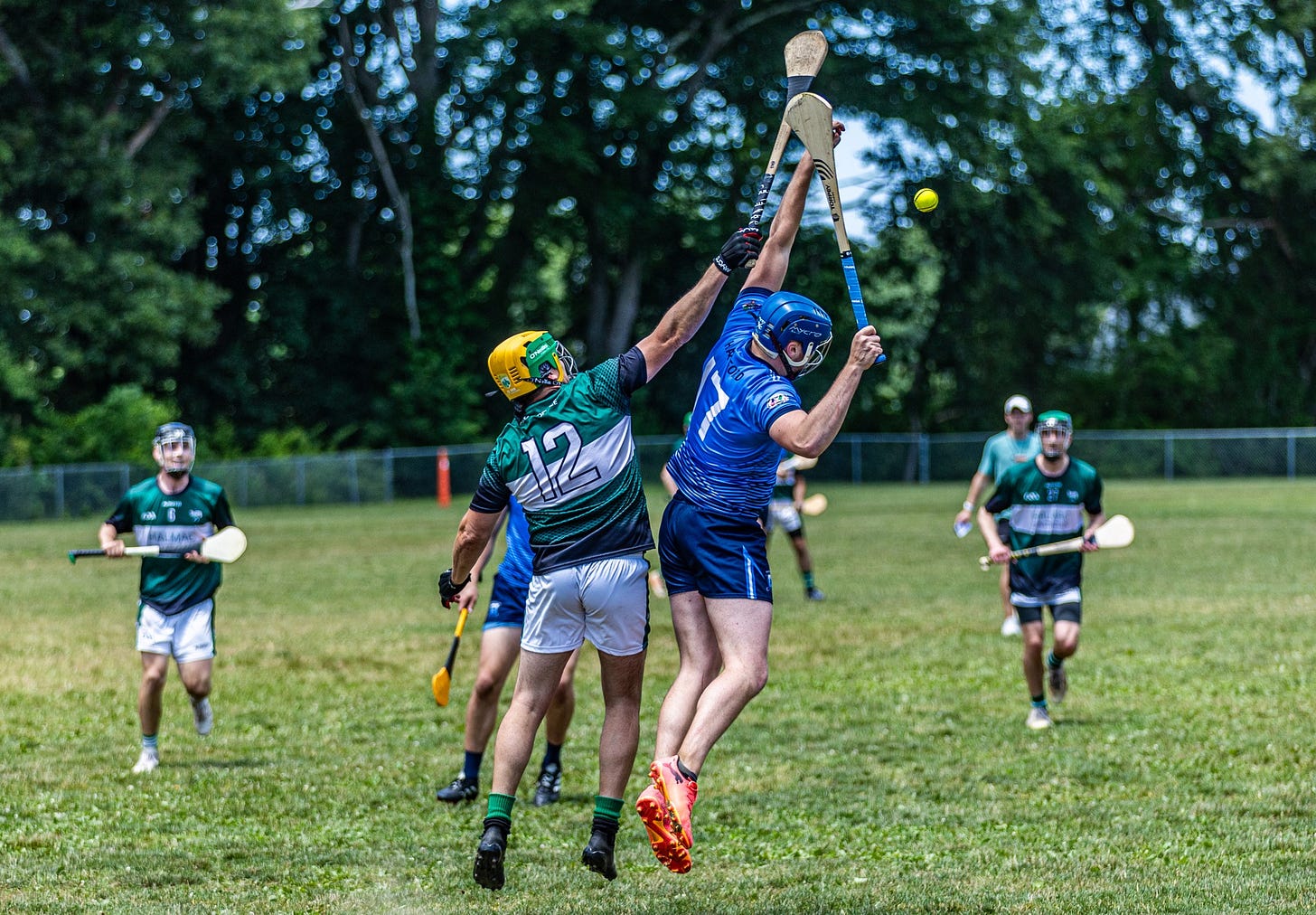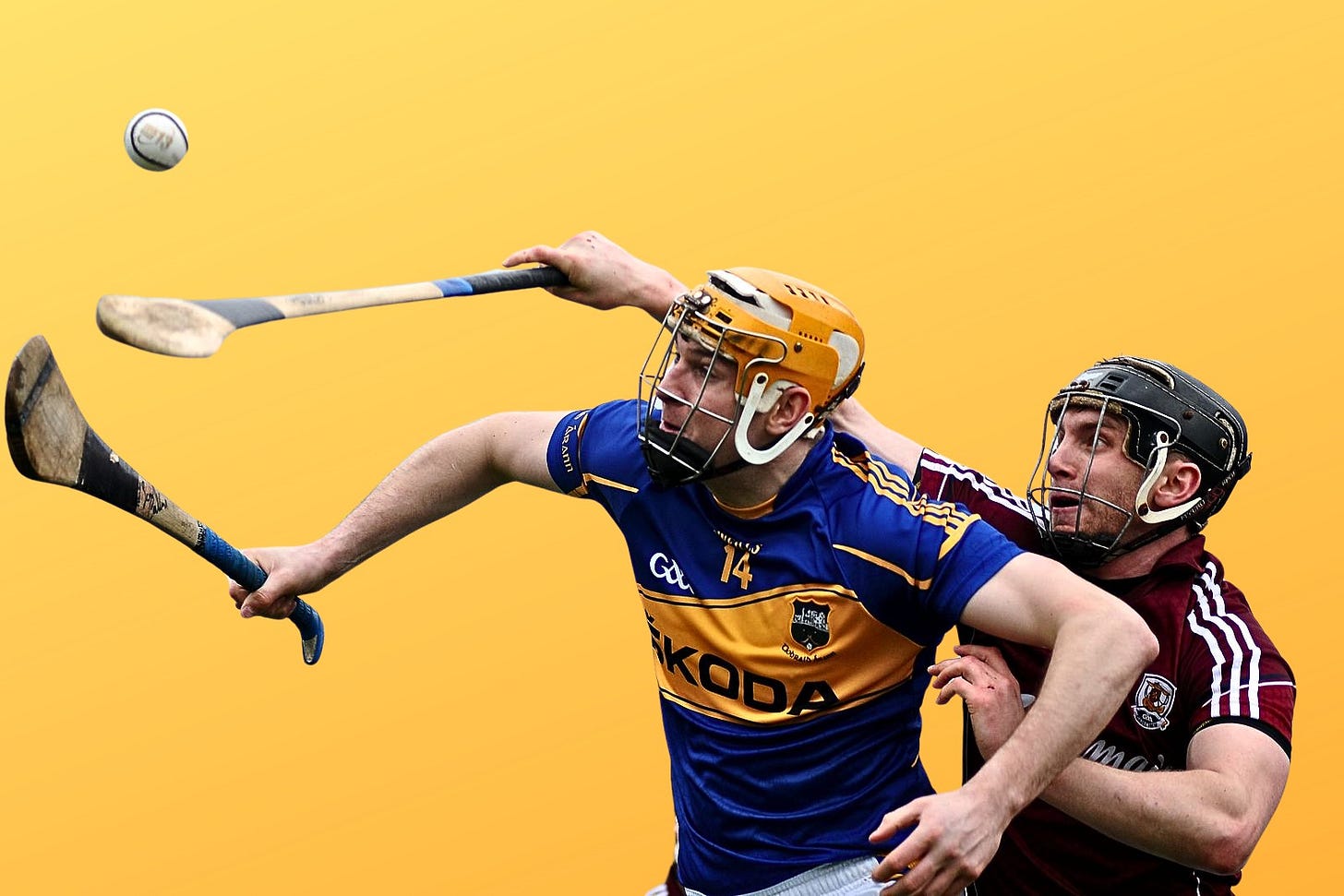A Brief History of Hurling
If Lacrosse represents the oldest athletic traditions in the Americas, then Hurling must be its ancient Celtic cousin.1
It’s been called ‘the fastest game on grass’ — and no wonder. Hurling (Irish: iomáint) is physical, quick-paced, and often chaotic. The ball itself can be propelled on the field at speeds reaching 150 kph (90-100mph). And at its best, the game is sometimes even beautiful.
Some form of Hurling has been played in Ireland for possibly 3,000 years, with the first literary reference to a game like Hurling seen in 1272 BCE. For those in the know, that’d be early in the reign of Egypt’s Ramesses II, and shortly after the fall of Troy.2
Essence of the Sport
Hurling’s modern form took shape in the 19th century and was promoted by Ireland’s nascent Gaelic Athletic Association, which sprang up in 1884 to organize increasingly popular inter-city and inter-village matches. Today, the GAA promotes these amateur sports in Ireland and around the world.
Played with a curved stick called a hurley, and a ball slightly larger than a tennis ball, known as a sliotar, most variations are played with 15 on each team, on a pitch between 130-145m (140-160 yards) long, and 90m wide (~100 yards).
Players use the hurley to hit the sliotar between an opponent’s goalposts — either over the crossbar for one point, or under the crossbar into a net guarded by a goalkeeper for a goal, which is equivalent to three points. Games are between 60 and 70 minutes in length, (30-35 minutes per half).

The sliotar can also be caught in the hand and carried for not more than four steps, struck in the air, or struck on the ground with the hurley. The ball can also be kicked, or slapped with an open hand (a hand pass) for short-range passing. Players who want to carry the ball for more than four steps have to bounce or balance the sliotar on the end of the stick.
Today’s sport originates mainly from one of Ireland’s Hurling traditions. There were once two distinct flavors of Hurling on the island — one was played with a narrow stick and a hard ball, and might have been familiar to modern players of Scottish Shinty.
Then there was ‘Leinster’ Hurling, which used a broader hurley and a softer ball. This had the biggest influence on the modern sport — but scholars aren’t certain which version of the game was played first.3
Ancient Hurling
In the mythological Cath Maige Tuired (The Battle of Magh Tuireadh), surviving versions of which were written down by early medieval monks, competing Irish warriors played a game similar to hurling against one another before going into battle.
That mythic match-up was nearly as violent as the next day’s fight and ended in a draw, with none of the 54 players able to continue. There were many broken bones — and some participants were even killed.4
To give you a sense for just how brutal the old game could be, later 7th & 8th century C.E. texts described actual injuries sustained in Hurling and how each should be monetarily compensated.

Tain Bo Cuailgne, an Irish epic which tells the tale of the Ulster warrior Cú Chullainn (the Hound of Culan), describes a contest resembling Hurling at several points in the narrative. Surviving versions of the tale date to the 12th century CE, but it’s been convincingly argued that it actually dates to 400 – 500 BCE.
The English tried — and failed spectacularly — to ban Hurling during the Middle Ages, after they had colonized Ireland. The Statutes of Kilkenny, passed in 1366, attempted to curb practices that were deemed “too Celtic,” and Hurling happened to be one of them. It turns out the Anglo-Norman settlers were becoming more like the Irish, rather than the other way round.
“it is ordained… that the commons of the said land of Ireland use not henceforth the games which men call Hurling, with great Clubs and Ball upon the ground, but that they apply and accustom themselves to use and throw lances, and other gentle games which pertain to arms.”5
The law was so harsh, and so unpopular, that it was hardly enforced in Kilkenny or outside of it. Hurling sticks and Sliotars dating to the middle ages have since been been pulled out of bogs across Ireland.6
It’s no small irony that Kilkenny’s club today is considered to be one the sports powerhouses, holding 19 Division I titles, tied for first with Tipperary.
Revival
Hurling and Gaelic Football’s surge in popularity rather neatly coincided with the rise of Irish Nationalism at the turn of the 20th century. That’s no accident. The Gaelic Athletic Association itself was originally conceived as a nationalist organization working to preserve and promote the traditions of Irish sport. Its founder, Michael Cusack, believed that the spread of English games was undermining Ireland’s national identity.7

As a testament to Ireland’s cultural diaspora, today there are Hurling groups across the world. This is particularly true in America, where there are loosely organized clubs to be found around the country.
"Origin & History," World Lacrosse, accessed June 18, 2024, https://worldlacrosse.sport/the-game/origin-history/.
David Connolly, "How Hurling Helped Ireland Defeat the British Empire," The Collector on Medium, accessed June 18, 2024, https://medium.com/the-collector/how-hurling-helped-ireland-defeat-the-british-empire-5cd322758d35.
"Hurling: Its Ancient History," Irish Archaeology, September 26, 2011, accessed June 18, 2024, http://irisharchaeology.ie/2011/09/hurling-its-ancient-history/.
"Ancient Hurling at Cunga," ClanDonnell, accessed June 18, 2024, https://clandonnell.net/ancient-hurling-at-cunga/.
Robert Dunbar, "The Statute of Kilkenny," History Today, accessed June 18, 2024, https://www.historytoday.com/archive/months-past/statute-kilkenny.
Paul Rouse, "Hurling: The Roots and Origins of Ireland's National Game," RTÉ Brainstorm, July 14, 2024, accessed June 18, 2024, https://www.rte.ie/brainstorm/2024/0714/980751-hurling-roots-origins-history-gaa-the-game-paul-rouse/.
Mike Cronin, "The GAA and the Development of Nationalism," History Ireland, accessed June 18, 2024, https://www.historyireland.com/the-gaa-and-the-development-of-nationalism/.






